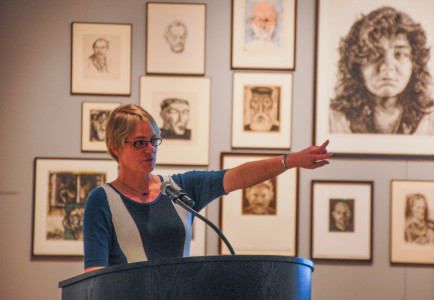
What do Kandinsky, Klee and Bloch have in common? They are all known in the art history world as German Expressionist painters but claim diverse countries of origin. As Professor Jenny Anger, Art, pointed out in her talk on “German Expressionism and America,” the German Expressionist movement was known for its internationalism.
On Tuesday, Feb. 24, Anger presented her most recent research on “Der Sturm” to a group of faculty, staff and students in the Faulconer Gallery.
Throughout her entire academic career, Anger said she has fallen in love with German Expressionism and German art.
“It started out of my junior year abroad in Germany and I was learning German, getting to know the culture and getting to know the art,” Anger said. “When I went to graduate school, I wanted to use my German and I happened to see a show at the Museum of Modern Art in 1987 that was about Paul Klee and I was thrilled by it. When I was trying to figure out what to do for a dissertation topic, and I finally had a professor say to me, ‘What do you love?’ And I knew immediately: Paul Klee. ‘What would you do with that?’ he asked. So, he sent me home to think about it and so that was my first book.”
Since her dissertation, Anger’s research has focused on German Expressionism with a particular emphasis on Paul Klee.
“It is such an international movement. We do so much that focuses on nationalism and so many students today think that globalism is a new idea and there are very important networks from far earlier times,” Anger said. “The world has always been interconnected, and that’s something I like about this period and this art.”
Anger’s connection to German Expressionism in collaboration with the Faulconer Gallery can be traced back to 2002 when her exhibition seminar class curated an art show using art from a collection acquired from John L. and Roslyn Baskt Goldman. Since then, the Gallery has revisited the collection with the current show, “Playing It Forward,” curated by Daniel Strong, the College’s curator of exhibitions.
Anger’s 2012 article, “‘Der Sturm,’ the ‘Société Anonyme,’ and Modern Art in America” discusses Der Sturm, the major site for German Expressionism internationally, and Walter Godshaw, a collector of Der Sturm journals. Anger pointed out throughout her talk that Godshaw was rejected by the Museum of Modern Art after positing a generous offer in exchange for money to pursue his studies in Germany.
In the articles, Anger writes, “MoMA’s ‘no’ is emblematic of the disregard and forgetfulness that have long overshadowed the intricate connections between ‘Der Sturm’ and America.”
For many students, Anger’s talk challenged conventional modes of thinking about German Expressionism.
“I went because I loved the exhibit and German expressionism art. I was so surprised by the talk, though! I had no idea that German Expressionism was such an expansive moment—with regard to both time and space,” said Ellen Taylor ’18, who attended the talk. “The Faulconer exhibition and Professor Anger’s talk dismantle the more traditional and reductive take people have on Expressionism and broaden the movement’s historic legacy to international and contemporary contexts.”




























































